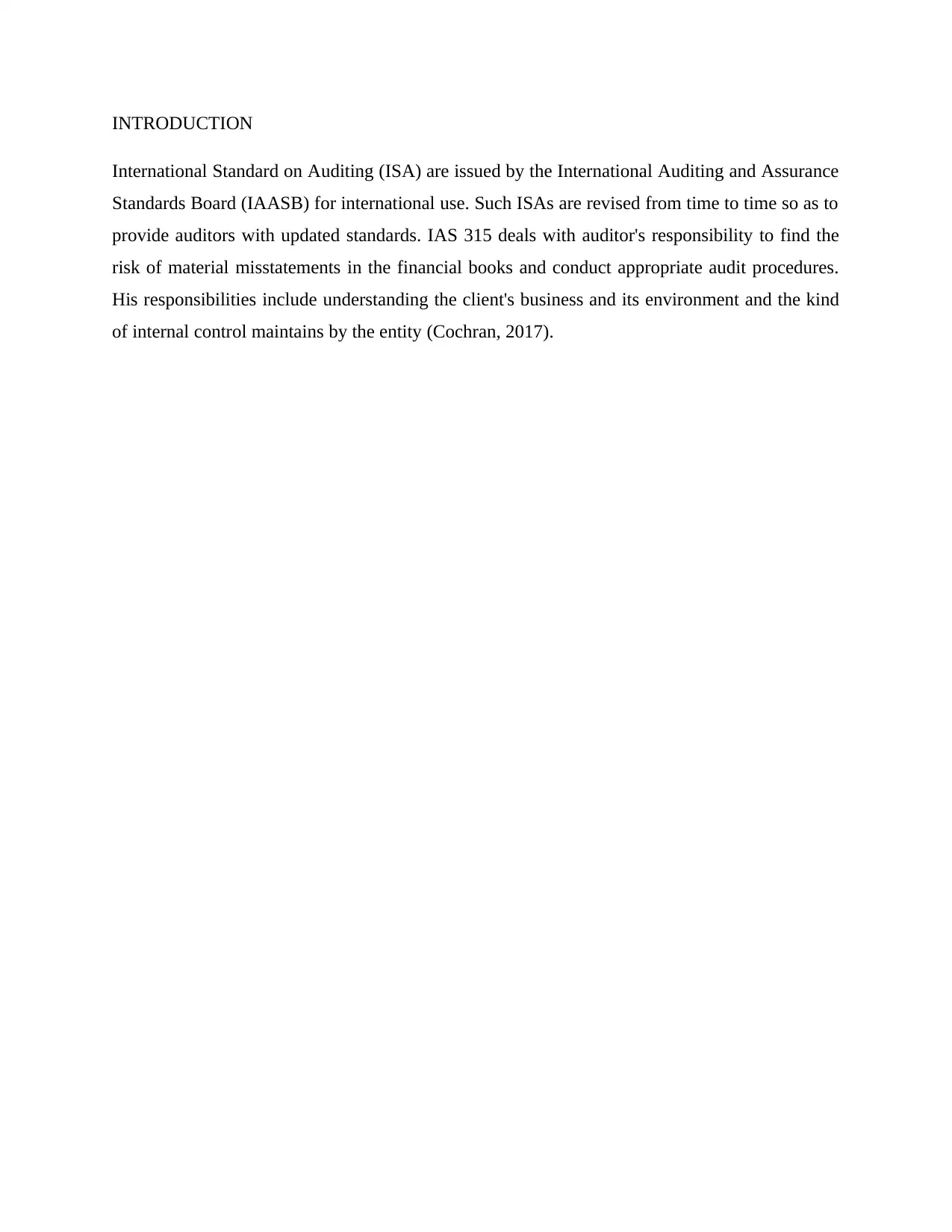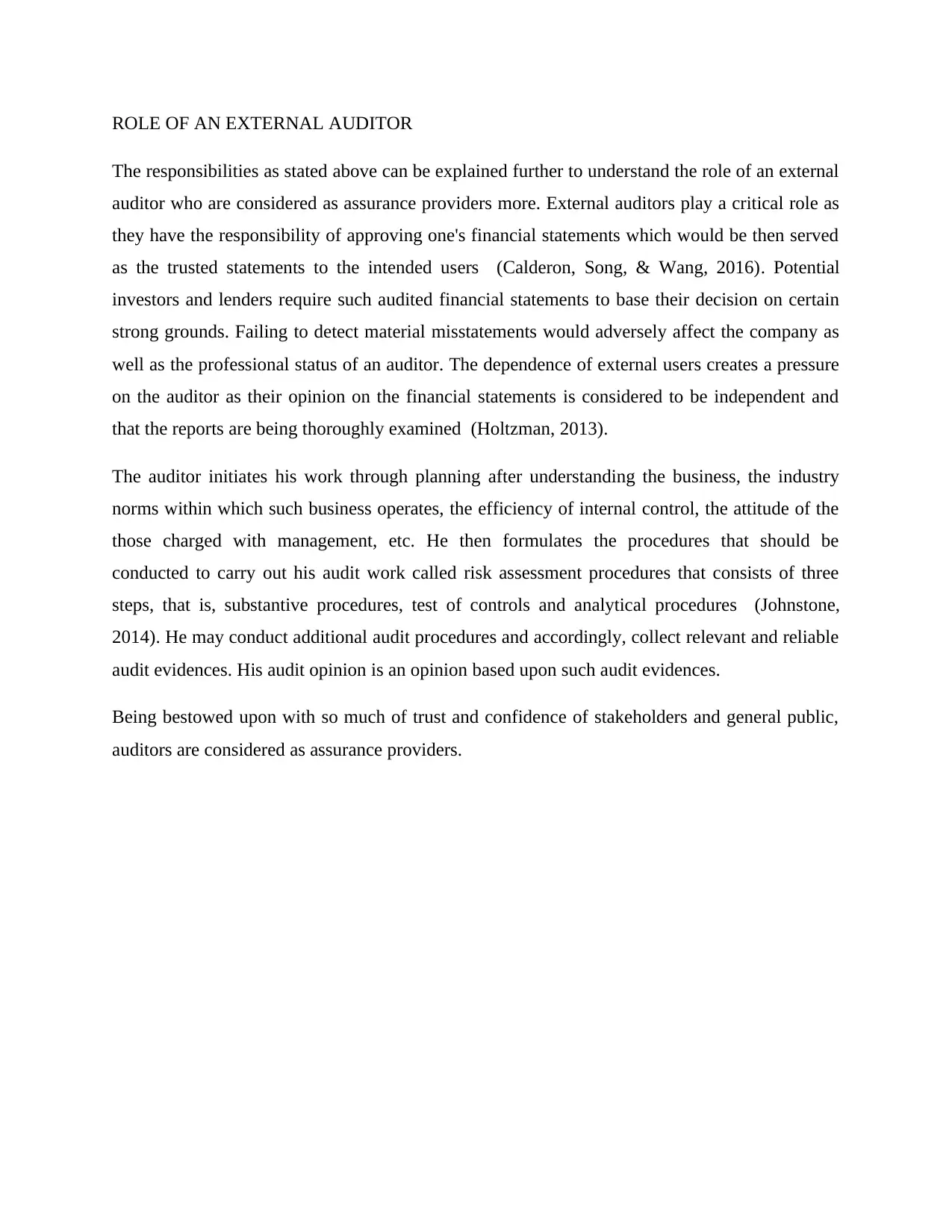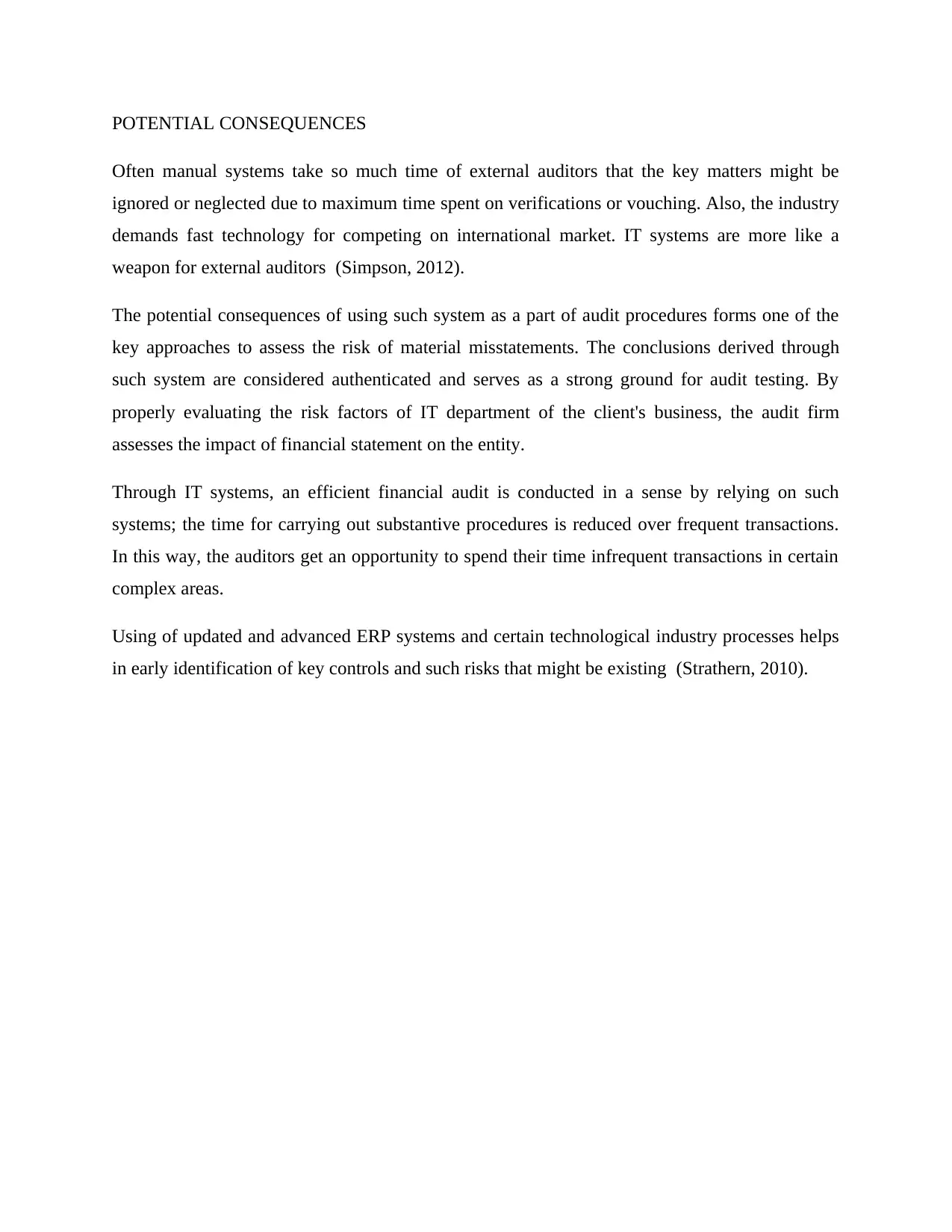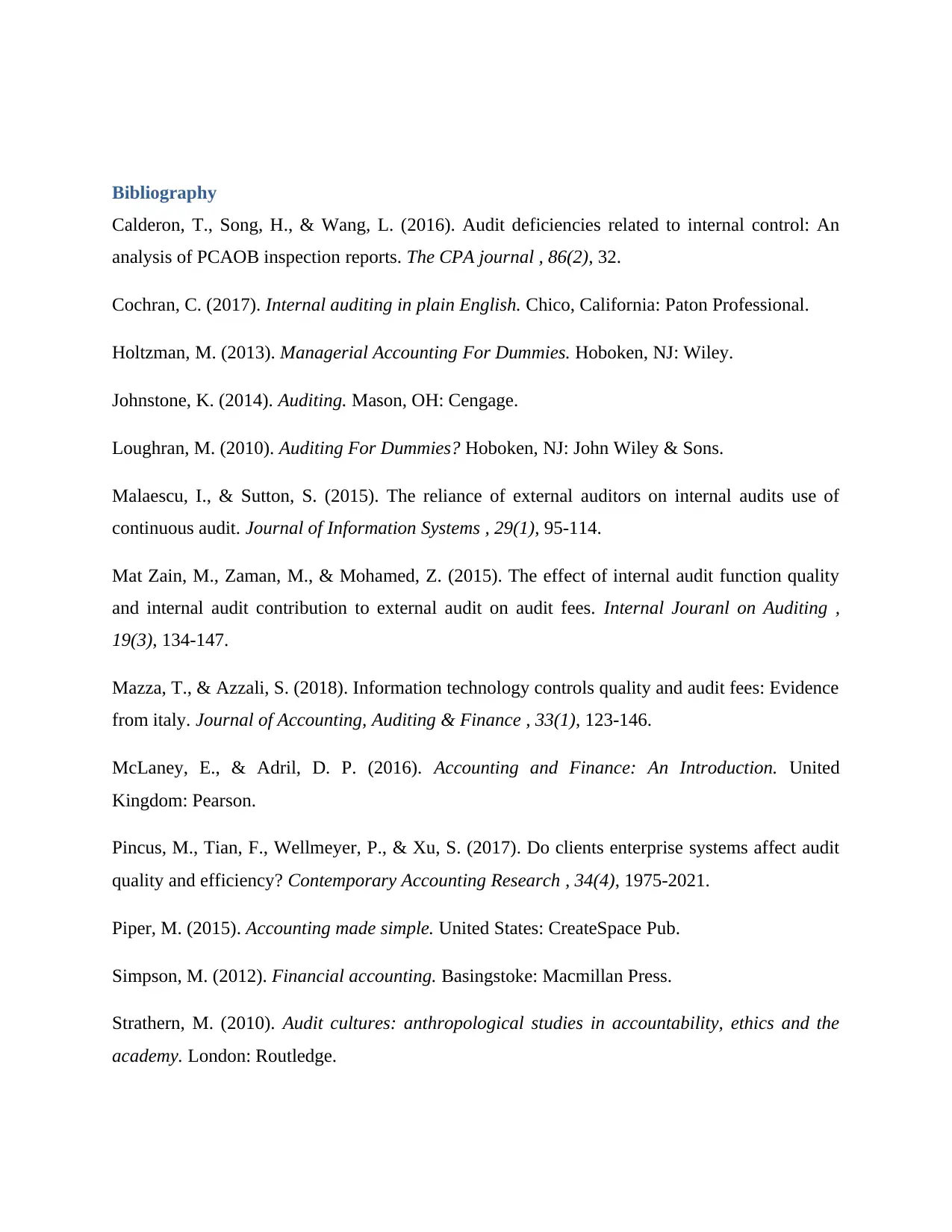The Significance of IT Systems in Enhancing Audit Efficiency
VerifiedAdded on 2023/06/07
|9
|1567
|401
Essay
AI Summary
This essay explores the crucial role of Information Systems (IS) in modern auditing practices. It highlights how external auditors rely on IT systems for efficient and effective audit work, emphasizing the importance of understanding a client's business environment and internal controls as per ISA 315. The essay details the responsibilities of external auditors in providing assurance on financial statements, the impact of IT systems on audit procedures such as substantive and analytical procedures, and the potential consequences of using these systems for risk assessment. It also addresses the expectations of both the client and the audit team regarding IT system controls and security, concluding with the necessity for the auditing industry to promote the importance of IT systems and updates for companies.

AUDITING
Paraphrase This Document
Need a fresh take? Get an instant paraphrase of this document with our AI Paraphraser

INTRODUCTION
International Standard on Auditing (ISA) are issued by the International Auditing and Assurance
Standards Board (IAASB) for international use. Such ISAs are revised from time to time so as to
provide auditors with updated standards. IAS 315 deals with auditor's responsibility to find the
risk of material misstatements in the financial books and conduct appropriate audit procedures.
His responsibilities include understanding the client's business and its environment and the kind
of internal control maintains by the entity (Cochran, 2017).
International Standard on Auditing (ISA) are issued by the International Auditing and Assurance
Standards Board (IAASB) for international use. Such ISAs are revised from time to time so as to
provide auditors with updated standards. IAS 315 deals with auditor's responsibility to find the
risk of material misstatements in the financial books and conduct appropriate audit procedures.
His responsibilities include understanding the client's business and its environment and the kind
of internal control maintains by the entity (Cochran, 2017).

ROLE OF AN EXTERNAL AUDITOR
The responsibilities as stated above can be explained further to understand the role of an external
auditor who are considered as assurance providers more. External auditors play a critical role as
they have the responsibility of approving one's financial statements which would be then served
as the trusted statements to the intended users (Calderon, Song, & Wang, 2016). Potential
investors and lenders require such audited financial statements to base their decision on certain
strong grounds. Failing to detect material misstatements would adversely affect the company as
well as the professional status of an auditor. The dependence of external users creates a pressure
on the auditor as their opinion on the financial statements is considered to be independent and
that the reports are being thoroughly examined (Holtzman, 2013).
The auditor initiates his work through planning after understanding the business, the industry
norms within which such business operates, the efficiency of internal control, the attitude of the
those charged with management, etc. He then formulates the procedures that should be
conducted to carry out his audit work called risk assessment procedures that consists of three
steps, that is, substantive procedures, test of controls and analytical procedures (Johnstone,
2014). He may conduct additional audit procedures and accordingly, collect relevant and reliable
audit evidences. His audit opinion is an opinion based upon such audit evidences.
Being bestowed upon with so much of trust and confidence of stakeholders and general public,
auditors are considered as assurance providers.
The responsibilities as stated above can be explained further to understand the role of an external
auditor who are considered as assurance providers more. External auditors play a critical role as
they have the responsibility of approving one's financial statements which would be then served
as the trusted statements to the intended users (Calderon, Song, & Wang, 2016). Potential
investors and lenders require such audited financial statements to base their decision on certain
strong grounds. Failing to detect material misstatements would adversely affect the company as
well as the professional status of an auditor. The dependence of external users creates a pressure
on the auditor as their opinion on the financial statements is considered to be independent and
that the reports are being thoroughly examined (Holtzman, 2013).
The auditor initiates his work through planning after understanding the business, the industry
norms within which such business operates, the efficiency of internal control, the attitude of the
those charged with management, etc. He then formulates the procedures that should be
conducted to carry out his audit work called risk assessment procedures that consists of three
steps, that is, substantive procedures, test of controls and analytical procedures (Johnstone,
2014). He may conduct additional audit procedures and accordingly, collect relevant and reliable
audit evidences. His audit opinion is an opinion based upon such audit evidences.
Being bestowed upon with so much of trust and confidence of stakeholders and general public,
auditors are considered as assurance providers.
⊘ This is a preview!⊘
Do you want full access?
Subscribe today to unlock all pages.

Trusted by 1+ million students worldwide

INFORMATION SYSTEMS
However, we cannot expect auditor conducting such procedures manually. He needs to be real
fast during his work and this is where the IT systems comes into the picture. Earlier, where the
work was totally done on an manual basis, such manual pressure has been taken over by the
technology advancements (Malaescu & Sutton, 2015).
Information Systems (IS) is an advanced level of controlled & organized systems where the
information is collected, organized, stored and communicated. More precisely, it involves
networks that an organization uses to increase the efficiency and effectiveness of its operations.
No matter what the size is, organizations have believed that to move ahead in the competition,
they need to opt secured and reliable IT systems that are not vulnerable to computer attacks.
Having recognized various benefits of an organization can enjoy through IT systems, it has
started making huge investments in having such systems in the operating environment
(Loughran, 2010).
Where the world is transforming itself into a technology based environment, we visualize the
level of trust being built on IT systems, which is increasing day by day (Mat Zain, Zaman, &
Mohamed, 2015). Where entities depend on IT systems for accurate and complete financial
reporting, external auditors rely on such controls and systems for conducting their audit work
effectively and efficiently. The expectations of both the company and external auditor are:
Client: Their objective is to provide assurance to their shareholders that their IT systems
are effectively controlled and is supporting the business operations (McLaney & Adril,
2016).
Audit team: Their objective is to identify, test and report effectively for ensuring the
objectives of IT systems under the guidance of key audit matters (KAM). Basically, IT
systems provide assistance to auditors that the systems in use for accurate reporting of
financial matters are controlled and secured and in that way, the risk of error and fraud is
automatically minimized (Mazza & Azzali, 2018).
With the verification of security and control associated with the IT systems, the auditor’s
pressure of assessing the risk of material misstatements is reduced and also, the automated
However, we cannot expect auditor conducting such procedures manually. He needs to be real
fast during his work and this is where the IT systems comes into the picture. Earlier, where the
work was totally done on an manual basis, such manual pressure has been taken over by the
technology advancements (Malaescu & Sutton, 2015).
Information Systems (IS) is an advanced level of controlled & organized systems where the
information is collected, organized, stored and communicated. More precisely, it involves
networks that an organization uses to increase the efficiency and effectiveness of its operations.
No matter what the size is, organizations have believed that to move ahead in the competition,
they need to opt secured and reliable IT systems that are not vulnerable to computer attacks.
Having recognized various benefits of an organization can enjoy through IT systems, it has
started making huge investments in having such systems in the operating environment
(Loughran, 2010).
Where the world is transforming itself into a technology based environment, we visualize the
level of trust being built on IT systems, which is increasing day by day (Mat Zain, Zaman, &
Mohamed, 2015). Where entities depend on IT systems for accurate and complete financial
reporting, external auditors rely on such controls and systems for conducting their audit work
effectively and efficiently. The expectations of both the company and external auditor are:
Client: Their objective is to provide assurance to their shareholders that their IT systems
are effectively controlled and is supporting the business operations (McLaney & Adril,
2016).
Audit team: Their objective is to identify, test and report effectively for ensuring the
objectives of IT systems under the guidance of key audit matters (KAM). Basically, IT
systems provide assistance to auditors that the systems in use for accurate reporting of
financial matters are controlled and secured and in that way, the risk of error and fraud is
automatically minimized (Mazza & Azzali, 2018).
With the verification of security and control associated with the IT systems, the auditor’s
pressure of assessing the risk of material misstatements is reduced and also, the automated
Paraphrase This Document
Need a fresh take? Get an instant paraphrase of this document with our AI Paraphraser

system serves way faster and better than the manual systems. The audit procedures, whether
substantive or analytical procedures, are easily carried out by:
Using automated tool to check the accuracy of financial balances, consolidated balances,
cross checking of balances, etc.
Testing of any new financial system if implemented into the IT department and checking
data migrations (Piper, 2015) ;
Using sampling procedures in a more advanced manner so as to provide assurance about
audit of large population ;
Helps in understanding the key factors or controls within the client's business
environment (Pincus, Tian, Wellmeyer, & Xu, 2017) ;
Evaluating the effectiveness and designs of controls such as application controls, It
general controls, etc.
substantive or analytical procedures, are easily carried out by:
Using automated tool to check the accuracy of financial balances, consolidated balances,
cross checking of balances, etc.
Testing of any new financial system if implemented into the IT department and checking
data migrations (Piper, 2015) ;
Using sampling procedures in a more advanced manner so as to provide assurance about
audit of large population ;
Helps in understanding the key factors or controls within the client's business
environment (Pincus, Tian, Wellmeyer, & Xu, 2017) ;
Evaluating the effectiveness and designs of controls such as application controls, It
general controls, etc.

POTENTIAL CONSEQUENCES
Often manual systems take so much time of external auditors that the key matters might be
ignored or neglected due to maximum time spent on verifications or vouching. Also, the industry
demands fast technology for competing on international market. IT systems are more like a
weapon for external auditors (Simpson, 2012).
The potential consequences of using such system as a part of audit procedures forms one of the
key approaches to assess the risk of material misstatements. The conclusions derived through
such system are considered authenticated and serves as a strong ground for audit testing. By
properly evaluating the risk factors of IT department of the client's business, the audit firm
assesses the impact of financial statement on the entity.
Through IT systems, an efficient financial audit is conducted in a sense by relying on such
systems; the time for carrying out substantive procedures is reduced over frequent transactions.
In this way, the auditors get an opportunity to spend their time infrequent transactions in certain
complex areas.
Using of updated and advanced ERP systems and certain technological industry processes helps
in early identification of key controls and such risks that might be existing (Strathern, 2010).
Often manual systems take so much time of external auditors that the key matters might be
ignored or neglected due to maximum time spent on verifications or vouching. Also, the industry
demands fast technology for competing on international market. IT systems are more like a
weapon for external auditors (Simpson, 2012).
The potential consequences of using such system as a part of audit procedures forms one of the
key approaches to assess the risk of material misstatements. The conclusions derived through
such system are considered authenticated and serves as a strong ground for audit testing. By
properly evaluating the risk factors of IT department of the client's business, the audit firm
assesses the impact of financial statement on the entity.
Through IT systems, an efficient financial audit is conducted in a sense by relying on such
systems; the time for carrying out substantive procedures is reduced over frequent transactions.
In this way, the auditors get an opportunity to spend their time infrequent transactions in certain
complex areas.
Using of updated and advanced ERP systems and certain technological industry processes helps
in early identification of key controls and such risks that might be existing (Strathern, 2010).
⊘ This is a preview!⊘
Do you want full access?
Subscribe today to unlock all pages.

Trusted by 1+ million students worldwide

CONCLUSION
It is often a matter of concern that IT systems are a complex structure to understand by various
organizations and that is why, complex systems can raise issues regarding its implementation and
execution as per the company's requirements. In such a case, the auditing industry is required to
make an IT agenda to spread the importance of IT systems and update the companies about
improvements.
It is often a matter of concern that IT systems are a complex structure to understand by various
organizations and that is why, complex systems can raise issues regarding its implementation and
execution as per the company's requirements. In such a case, the auditing industry is required to
make an IT agenda to spread the importance of IT systems and update the companies about
improvements.
Paraphrase This Document
Need a fresh take? Get an instant paraphrase of this document with our AI Paraphraser

Bibliography
Calderon, T., Song, H., & Wang, L. (2016). Audit deficiencies related to internal control: An
analysis of PCAOB inspection reports. The CPA journal , 86(2), 32.
Cochran, C. (2017). Internal auditing in plain English. Chico, California: Paton Professional.
Holtzman, M. (2013). Managerial Accounting For Dummies. Hoboken, NJ: Wiley.
Johnstone, K. (2014). Auditing. Mason, OH: Cengage.
Loughran, M. (2010). Auditing For Dummies? Hoboken, NJ: John Wiley & Sons.
Malaescu, I., & Sutton, S. (2015). The reliance of external auditors on internal audits use of
continuous audit. Journal of Information Systems , 29(1), 95-114.
Mat Zain, M., Zaman, M., & Mohamed, Z. (2015). The effect of internal audit function quality
and internal audit contribution to external audit on audit fees. Internal Jouranl on Auditing ,
19(3), 134-147.
Mazza, T., & Azzali, S. (2018). Information technology controls quality and audit fees: Evidence
from italy. Journal of Accounting, Auditing & Finance , 33(1), 123-146.
McLaney, E., & Adril, D. P. (2016). Accounting and Finance: An Introduction. United
Kingdom: Pearson.
Pincus, M., Tian, F., Wellmeyer, P., & Xu, S. (2017). Do clients enterprise systems affect audit
quality and efficiency? Contemporary Accounting Research , 34(4), 1975-2021.
Piper, M. (2015). Accounting made simple. United States: CreateSpace Pub.
Simpson, M. (2012). Financial accounting. Basingstoke: Macmillan Press.
Strathern, M. (2010). Audit cultures: anthropological studies in accountability, ethics and the
academy. London: Routledge.
Calderon, T., Song, H., & Wang, L. (2016). Audit deficiencies related to internal control: An
analysis of PCAOB inspection reports. The CPA journal , 86(2), 32.
Cochran, C. (2017). Internal auditing in plain English. Chico, California: Paton Professional.
Holtzman, M. (2013). Managerial Accounting For Dummies. Hoboken, NJ: Wiley.
Johnstone, K. (2014). Auditing. Mason, OH: Cengage.
Loughran, M. (2010). Auditing For Dummies? Hoboken, NJ: John Wiley & Sons.
Malaescu, I., & Sutton, S. (2015). The reliance of external auditors on internal audits use of
continuous audit. Journal of Information Systems , 29(1), 95-114.
Mat Zain, M., Zaman, M., & Mohamed, Z. (2015). The effect of internal audit function quality
and internal audit contribution to external audit on audit fees. Internal Jouranl on Auditing ,
19(3), 134-147.
Mazza, T., & Azzali, S. (2018). Information technology controls quality and audit fees: Evidence
from italy. Journal of Accounting, Auditing & Finance , 33(1), 123-146.
McLaney, E., & Adril, D. P. (2016). Accounting and Finance: An Introduction. United
Kingdom: Pearson.
Pincus, M., Tian, F., Wellmeyer, P., & Xu, S. (2017). Do clients enterprise systems affect audit
quality and efficiency? Contemporary Accounting Research , 34(4), 1975-2021.
Piper, M. (2015). Accounting made simple. United States: CreateSpace Pub.
Simpson, M. (2012). Financial accounting. Basingstoke: Macmillan Press.
Strathern, M. (2010). Audit cultures: anthropological studies in accountability, ethics and the
academy. London: Routledge.

⊘ This is a preview!⊘
Do you want full access?
Subscribe today to unlock all pages.

Trusted by 1+ million students worldwide
1 out of 9
Related Documents
Your All-in-One AI-Powered Toolkit for Academic Success.
+13062052269
info@desklib.com
Available 24*7 on WhatsApp / Email
![[object Object]](/_next/static/media/star-bottom.7253800d.svg)
Unlock your academic potential
Copyright © 2020–2025 A2Z Services. All Rights Reserved. Developed and managed by ZUCOL.





